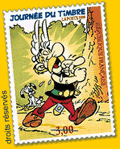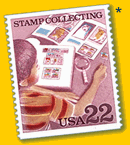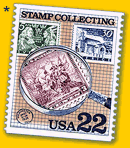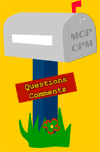 |
Stamp Stuff
Stamp collecting will be easier and more fun if you have the right
equipment.
- To avoid damaging your stamps, handle them with tongs.
Be sure to use rounded-end tongs, since tongs with sharp ends
can pierce a stamp.

- Attach your stamps with hinges or mounts so that you can remove them later.
To use a hinge:
-
 Fold over a third of the hinge, gummed side out
(some hinges are already folded). Fold over a third of the hinge, gummed side out
(some hinges are already folded).
-
 Moisten the short folded end of the hinge and attach it to
the back of the stamp, near the top. If you make a mistake,
let the hinge dry. It will come off the back of the stamp without
tearing. Moisten the short folded end of the hinge and attach it to
the back of the stamp, near the top. If you make a mistake,
let the hinge dry. It will come off the back of the stamp without
tearing.
-
 Wet the other end of the hinge and stick the stamp onto
the album page. Wet the other end of the hinge and stick the stamp onto
the album page.
To use a mount:
-
 Moisten the back of the mount or remove its backing paper
and stick the mount onto your album page. Moisten the back of the mount or remove its backing paper
and stick the mount onto your album page.
-
 Slip the stamp into the mount. Unlike a hinge, the mount is
not attached to the stamp, so it does not damage the gum of the stamp. Slip the stamp into the mount. Unlike a hinge, the mount is
not attached to the stamp, so it does not damage the gum of the stamp.
- Store your stamps in a stockbook or an album.
 Stockbooks have mounting strips into which you slide your stamps.
They are useful if you have not decided how you want to organize your collection. Stockbooks have mounting strips into which you slide your stamps.
They are useful if you have not decided how you want to organize your collection.
There is a vast range of albums to choose from.
Some albums have pictures of stamps printed in them. When you find
one of the stamps shown, you attach it on top of its picture. Other
albums have blank pages. You choose which stamps to include and how to organize them.
Sort your stamps according to how you plan to organize them in your
album. You can sort them by country, by date, or by theme, such as
animals, flowers, or sports.
Your stamps will look better if you do not put too many on a
page and if you keep the arrangement simple. Always decide how
you want to organize your stamps on a page before mounting them.
Be sure to leave enough space so that you can label each stamp.
- Use a magnifying glass to examine your stamps for details as well
as for tears or other damage.

- Use a catalogue to identify your stamps or find out more about them.
There are general world catalogues and more specialized ones that
focus on one or more countries. No matter which catalogue you use,
the stamps will be listed under the name of the issuing country in
date order. Each stamp will also be given a number, which will vary
depending on the catalogue used. For Canadian stamps, you can use
either the Scott or the Darnell numbering system.
- Use a perforation gauge to measure the
perforations along the edges
of stamps. Sometimes you need to know the size and number of perforations to identify stamps. If a catalogue lists a stamp as
perf 13 that means it has 13 complete perforations (teeth and holes)
in every two centimetres.
Measure the number of perforations on a stamp by sliding the perforation
gauge over the stamp until each tooth has a vertical line running exactly
through it. The figure on the left tells you the number of perforations.
* © United States Postal Service.
Reproduced with permission.
All rights reserved.
|
 |








 Fold over a third of the hinge, gummed side out
(some hinges are already folded).
Fold over a third of the hinge, gummed side out
(some hinges are already folded).
 Moisten the short folded end of the hinge and attach it to
the back of the stamp, near the top. If you make a mistake,
let the hinge dry. It will come off the back of the stamp without
tearing.
Moisten the short folded end of the hinge and attach it to
the back of the stamp, near the top. If you make a mistake,
let the hinge dry. It will come off the back of the stamp without
tearing.
 Wet the other end of the hinge and stick the stamp onto
the album page.
Wet the other end of the hinge and stick the stamp onto
the album page.
 Stockbooks have mounting strips into which you slide your stamps.
They are useful if you have not decided how you want to organize your collection.
Stockbooks have mounting strips into which you slide your stamps.
They are useful if you have not decided how you want to organize your collection.
